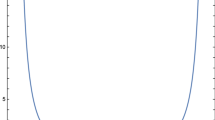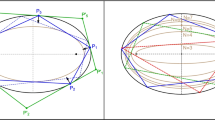Abstract
The behavior of a point particle traveling with a constant speed in a region \(D\subset R^{N}\) , undergoing elastic collisions at the regions’s boundary, is known as the billiard problem. Various billiard models serve as approximation to the classical and semi-classical motion in systems with steep potentials (e.g. for studying classical molecular dynamics, cold atom’s motion in dark optical traps and microwave dynamics). Here we develop methodologies for examining the validity and accuracy of this approximation. We consider families of smooth potentials \(V_\epsilon\) , that, in the limit \(\epsilon\rightarrow0\) , become singular hard-wall potentials of multi-dimensional billiards. We define auxiliary billiard domains that asymptote, as \(\epsilon\rightarrow0\) to the original billiards, and provide, for regular trajectories, asymptotic expansion of the smooth Hamiltonian solution in terms of these billiard approximations. The asymptotic expansion includes error estimates in the C r norm and an iteration scheme for improving this approximation. Applying this theory to smooth potentials that limit to the multi-dimensional close to ellipsoidal billiards, we predict when the billiard’s separatrix splitting (which appears, for example, in the nearly flat and nearly oblate ellipsoids) persists for various types of potentials.
Similar content being viewed by others
References
Baldwin P.R. (1988). Soft billiard systems. Phys. D 29(3): 321–342
Bálint P., Chernov N., Szász D. and Tóth I. (2003). Geometry of multi-dimensional dispersing billiards. Astérisque 286: 119–150
Bálint P. and Tóth I.P. (2004). Mixing and its rate in ‘soft’ and ‘hard’ billiards motivated by the Lorentz process. Phys. D 187(1–4): 128–135
Bálint P. and Tóth I.P. (2006). Hyperbolicity in multi-dimensional Hamiltonian systems with applications to soft billiards. Discrete Contin. Dyn. Syst. 15(1): 37–59
Birkhoff, G.D.: Dynamical systems. Amer. Math. Soc. Colloq. Publ. 9, New York: Amer. Math. Soc., 1927
Bolotin S., Delshams A. and Ramírez-Ros R. (2004). Persistence of homoclinic orbits for billiards and twist maps. Nonlinearity 17(4): 1153–1177
Bunimovich L.A. (1979). On the ergodic properties of nowhere dispersing billiards. Commun. Math. Phys. 65(3): 295–312
Bunimovich L.A. and Rehacek J. (1997). Nowhere dispersing 3D billiards with non-vanishing Lyapunov exponents. Commun. Math. Phys. 189(3): 729–757
Bunimovich L.A. and Rehacek J. (1998). How high-dimensional stadia look like. Commun. Math. Phys. 197(2): 277–301
Bunimovich L.A. and Rehacek J. (1998). On the ergodicity of many-dimensional focusing billiards. Ann. Inst. H. Poincaré Phys. Théor. 68(4): 421–448
Bunimovich L.A. and Del Magno G. (2006). Semi-focusing billiards: hyperbolicity. Commun. Math. Phys. 262(1): 17–32
Chen Y-C. (2004). Anti-integrability in scattering billiards. Dyn. Syst. 19(2): 145–159
Chernov, N., Markarian, R.: Introduction to the ergodic theory of chaotic billiards. Second ed., Publicações Matemáticas do IMPA. [IMPA Mathematical Publications], Instituto de Matemática Pura e Aplicada (IMPA), Rio de Janeiro, 2003, 24o Colóquio Brasileiro de Matemática. [24th Brazilian Mathematics Colloquium]
Delshams A., Fedorov Yu. and Ramírez-Ros R. (2001). Homoclinic billiard orbits inside symmetrically perturbed ellipsoids. Nonlinearity 14(5): 1141–1195
Delshams A. and Ramírez-Ros R. (1996). Poincaré-Melnikov-Arnold method for analytic planar maps. Nonlinearity 9: 1–26
Delshams A. and Ramírez-Ros R. (1997). Melnikov potential for exact symplectic maps. Commun. Math. Phys. 190(1): 213–245
Donnay V.J. (1996). Elliptic islands in generalized Sinai billiards. Ergod. Th. & Dynam. Sys. 16: 975–1010
Donnay V.J. (1999). Non-ergodicity of two particles interacting via a smooth potential. J. Stat. Phys. 96(5–6): 1021–1048
Donnay V.J. and Liverani C. (1991). Potentials on the two-torus for which the Hamiltonian flow is ergodic. Commun. Math. Phys. 135: 267–302
Dragović V. and Radnović M. (2004). Cayley-type conditions for billiards within k quadrics in \({\mathbb{R}}^d\) J. Phys. A 37(4): 1269–1276
Guckenheimer J. and Holmes P. (1983). Non-linear oscillations, dynamical systems and bifurcations of vector fields. Springer-Verlag, New York, NY
Gutzwiller M.C. (1990). Chaos in classical and quantum mechanics. Springer-Verlag, New York, NY
Hale, J.K.: Ordinary differential equations. Second ed., Huntington, NY: Robert E. Krieger Publishing Co. Inc., 1980
Kaplan, A., Friedman, N., Andersen, M., Davidson, N.: Observation of islands of stability in soft wall atom-optics billiards. Phy. Rev. Lett. 87(27) 274101–1–4 (2001)
Knauf A. (1989). On soft billiard systems. Phys. D 36(3): 259–262
Kozlov, V.V., Treshchëv, D.V.: Billiards: A genetic introduction to the dynamics of systems with impacts. Providence, RI: Amer. Math. Soc. 1991 (Translated from the Russian by J. R. Schulenberger)
Krámli A., Simányi N. and Szász D. (1989). Ergodic properties of semi-dispersing billiards. I. Two cylindric scatterers in the 3D torus. Nonlinearity 2(2): 311–326
Krámli A., Simányi N. and Szász D. (1990). A “transversal” fundamental theorem for semi-dispersing billiards. Commun. Math. Phys. 129(3): 535–560
Krámli, A., Simányi, N., Szász, D.: The K-property of three billiard balls. Ann. of Math. (2) 133(1), 37–72 (1991)
Krámli A., Simányi N. and Szász D. (1992). The K-property of four billiard balls. Commun. Math. Phys. 144(1): 107–148
Krylov, N.S.: Works on the foundations of statistical physics. Princeton, NJ: Princeton University Press, 1979. Translated from the Russian by A. B. Migdal, Ya. G. Sinai [Ja. G. Sinaǐ], Yu. L. Zeeman [Ju. L. Zeeman], with a preface by A. S. Wightman, with a biography of Krylov by V. A. Fock [V. A. Fok], with an introductory article “The views of N. S. Krylov on the foundations of statistical physics” by Migdal and Fok, with a supplementary article “Development of Krylov’s ideas” by Sinaǐ, Princeton Series in Physics
Kubo I. (1976). Perturbed billiard systems. I. The ergodicity of the motion of a particle in a compound central field. Nagoya Math. J. 61: 1–57
Kubo I. and Murata H. (1981). Perturbed billiard systems II. Bernoulli properties. Nagoya Math. J. 81: 1–25
Lerman, L.M., Umanskiy, Ya.L.: Four-dimensional integrable Hamiltonian systems with simple singular points (topological aspects). Translations of Mathematical Monographs, Vol. 176, Providence, RI: Amer. Math. Soc. 1998. Translated from the Russian manuscript by A. Kononenko and A. Semenovich
Markarian R. (1992). Ergodic properties of plane billiards with symmetric potentials. Commun. Math. Phys. 145(3): 435–446
Markarian R. (2004). Billiards with polynomial decay of correlations. Ergodic Theory Dynam. Systems 24(1): 177–197
Marsden J.E. (1967/1968). Generalized Hamiltonian mechanics: A mathematical exposition of non-smooth dynamical systems and classical Hamiltonian mechanics. Arch. Rational Mech. Anal. 28: 323–361
Marsden J.E. and West M. (2001). Discrete mechanics and variational integrators. Acta Numer. 10: 357–514
Papenbrock T. (2000). Numerical study of a three-dimensional generalized stadium billiard. Phys. Rev. E 61(1, 4626–4628): 61–1, 46264628
Primack H. and Smilansky U. (2000). The quantum three-dimensional Sinai billiard—a semiclassical analysis. Phys. Rep. 327(1–2): 107
Rapoport A. and Rom-Kedar V. (2006). Non-ergodicity of the motion in three-dimensional steep repelling dispersing potentials. Chaos 16(4): 043108
Rapoport, A., Rom-Kedar, V., Turaev, D.: Stability in high dimensional steep repelling potentials (submitted, preprint, 2007)
Rom-Kedar V. and Turaev D. (1999). Big islands in dispersing billiard-like potentials. Physica D 130: 187–210
Shilnikov, L.P., Shilnikov, A.L., Turaev, D.V., Chua, L.O.: Methods of qualitative theory in nonlinear dynamics. Part I. World Scientific Series on Nonlinear Science. Series A: Monographs and Treatises, Vol. 4, River Edge, NJ: World Scientific Publishing Co. Inc., 1988
Simányi N. (1992). The K-property of N billiard balls. I. Invent. Math. 108(3): 521–548
Simányi N. (1992). The K-property of N billiard balls. II. Computation of neutral linear spaces. Invent. Math. 110(1): 151–172
Simányi N. (2004). Proof of the ergodic hypothesis for typical hard ball systems. Ann. Henri Poincaré 5(2): 203–233
Simányi N. and Szász D. (1999). Hard ball systems are completely hyperbolic. Ann. of Math. (2) 149(1): 35–96
Sinai Ya.G. (1963). On the foundations of the ergodic hypothesis for dynamical system of statistical mechanics. Dokl. Akad. Nauk. SSSR 153: 1261–1264
Sinai Ya.G. (1970). Dynamical systems with elastic reflections: Ergodic properties of scattering billiards. Russ. Math. Sur. 25(1): 137–189
Sinai, Ya.G., Chernov, N.I., Ergodic properties of some systems of two-dimensional disks and three-dimensional balls. Usp. Mat. Nauk 42(3)(255), 153–174, 256 (1987) (in Russian)
Smilansky, U.: Semiclassical quantization of chaotic billiards - a scattering approach, Proceedings of the 1994 Les-Houches Summer School on “Mesoscopic quantum Physics” A. Akkermans, G. Montambaux, J.L. Pichard, eds., Amsterdam: North Holland, 1995
Szász D. (1996). Boltzmann’s ergodic hypothesis, a conjecture for centuries? Studia Sci. Math. Hungar. 31(1–3): 299–322
Szasz, D. (ed.): Hard ball systems and the lorentz gas, Encyclopaedia of Mathematical Sciences, Vol. 101, New York, NY: Springer-Verlag, 2000
Tabachnikov, S.: Billiards. Panor. Synth. 1, vi+142 (1995)
Turaev D. and Rom-Kedar V. (1998). Islands appearing in near-ergodic flows. Nonlinearity 11(3): 575–600
Turaev D. and Rom-Kedar V. (2003). Soft billiards with corners. J. Stat. Phys. 112(3–4): 765–813
Veselov, A.P.: Integrable mappings. Usp. Mat. Nauk 46(5(281)), 3–45, 190 (1991)
Wojtkowski M. (1990). Linearly stable orbits in 3-dimensional billiards. Commun. Math. Phys. 129(2): 319–327
Young, L-S.: Statistical properties of dynamical systems with some hyperbolicity. Ann. of Math. (2) 147(3), 585–650 (1998)
Zaslavsky G.M. and Strauss H.R. (1992). Billiard in a barrel. Chaos 2(4): 469–472
Author information
Authors and Affiliations
Corresponding author
Additional information
Communicated by G. Gallavotti
Rights and permissions
About this article
Cite this article
Rapoport, A., Rom-Kedar, V. & Turaev, D. Approximating Multi-Dimensional Hamiltonian Flows by Billiards. Commun. Math. Phys. 272, 567–600 (2007). https://doi.org/10.1007/s00220-007-0228-0
Received:
Accepted:
Published:
Issue Date:
DOI: https://doi.org/10.1007/s00220-007-0228-0




